Though I have never been or never desire to be a killer much of my life’s success was predicated on keeping a set of razor sharp knifes. Again, I am not an assassin but I was a chef for many years. On the hot line and in food preparation it is of the utmost importance that you have a properly sharpened tool to do the job. When a day’s work consists of filleting whole salmon and slicing herbs so fine they are hardly recognizable these blades become the most important part of your success.
This is no difference in a survival situation. The blade is by far the most important tool in your kit. I would argue its only rival would be a powerful water filter. Still, with a knife you can create a filter from various materials yet with a water filter you cannot create a knife. Let’s move on.
Tools
1. Wet Stone
In order to sharpen any blade you are going to need something that will work the edges of the blade back to a sharpened edge. The wet stone provides you with a smooth surface that will slowly wear down each side of the blade until your edge is sharpened.
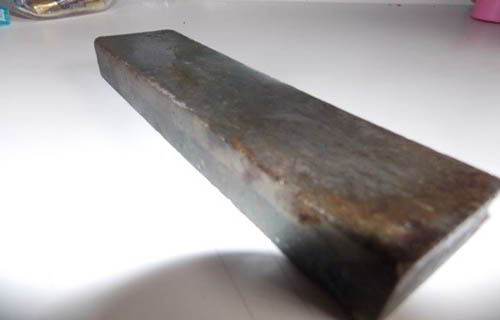
When buying a water stone (must be kept 40min in water before), look for a large one, at least 2.5 inches wide by 8 inches long, and an inch in thickness. I recommend keeping two stones in your kit. One with a medium grit (around 800 or so) to perform major sharpening jobs, and one with a fine grit (at least 2,000) to tune the edge to a razor-sharp finish. (J. Kenji Lopez-Alt – Source)
2. Honing Steel
The honing steel a powerful tool that with align and hone the blade on a knife. In many cases knife that is not performing well can be brought back to life with several swipes on a honing steel rather than shaving away at the metal to create a new blade.
A tool that is used more often in kitchens it’s a powerful and effective means to keeping a strong blade.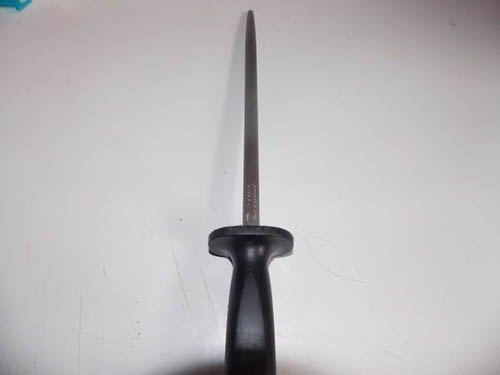
The Method:
#Step 1
Your first step is getting an idea about what your blade needs. When I am going to sharpen a blade I first take a look at the knife as a whole to decide how it will best be held, what is the shape of the blade and how best to attack the problem.
#Step 2
Some blades curve some blades are more flat and all of this will dictate how you sharpen the blade. You will need to make sure that your movements on the stone touch each part of the blade. If you aren’t careful you could wind up with a blade that is razor sharp at one end and dull at the other.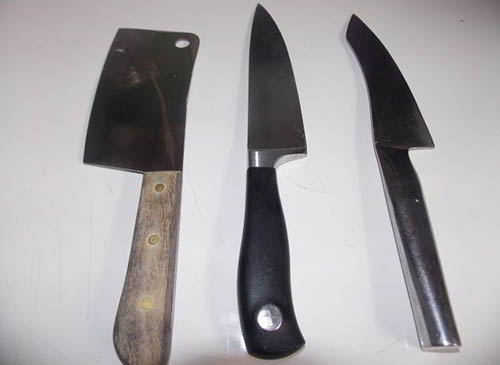
#Step 3
Lay out a towel or something that will hold stone in place so it doesn’t shift as you begin to run the knife blade across it.
#Step 4
Now before we even start to sharpen a blade I run it across the sharpening steel in a descending manner on both sides. Hold the knife at a 45 degree angle to the blade. I start with 3 swipes on each side of the blade and decrease down to 2 and then finally one swipe on each side. From doing this you will either find the blade has been realigned and is much sharper or its still dull. If your knife doesn’t spring back to life than its time to sharpen it.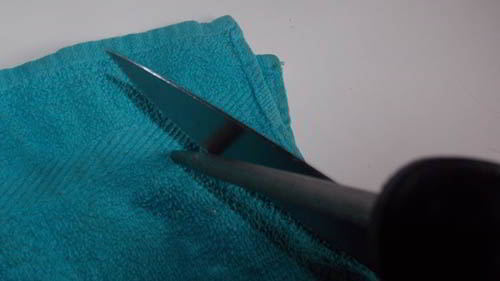
#Step 5
Run the blade across the stone in a perpendicular direction to the stone itself. Start with the widest part of the blade and work your way up to the point sliding forward and sliding back.
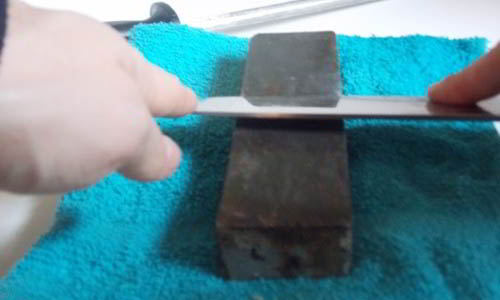
The first factor effecting edge sharpness is the angle it is sharpened. The lower the angle, the sharper the blade becomes.
However, the lower the angle, the weaker the edge becomes. A 22.5° should be perfect in most cases (see picture). But when choosing the angle you may take into consideration the hardness of the steel. (Source)
#Step 6
After three trips up and back on the stone it is time to do the other side. Leaving the stone stationery you need to flip your knife over keeping the blade facing away from you. And continue with the same method.
#Step 7
At this point use the honing steel with the method used above before sharpening the blade.
#Step 8
If the blade is razor sharp than you are good to go! If its still dull repeat steps 6 and 7 until your blade is fully sharpened.
If you are dealing with a blade that is well worn you may need to utilize another method first before taking the gentle approach. This is a tactic I learned from a Belgian chef. I had an old chef knife that followed me through several endeavors and it had been worn down pretty well.
This chef ran the knife blade parallel with the stone and did so about 20-25 hard strokes on each side before checking the blade and going back. This old man literally created a new blade on my knife using the stone and I was very impressed. Now it didn’t look pretty but that knife was brought back to life and I still use it some 10 years later.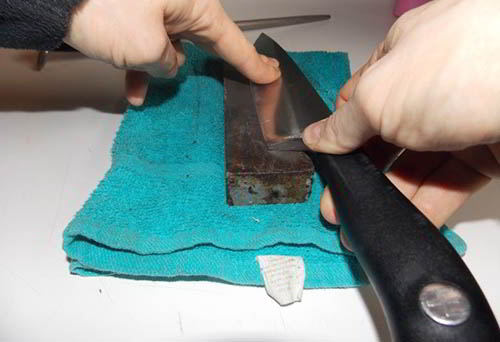
Sometimes it helps to cover the edge with permanent marker so you can see where you’re removing steel. Here you can see that you’re holding too high of an angle to match the angle already on the knife. Notice the permeant marker is removed from the edge but not the top of the secondary edge. Lower your angle slightly and check again. The opposite problem: too shallow of an angle (see picture).
Fine Tuning
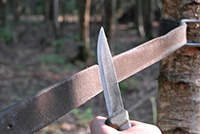 The final tool in the sharpening process is the leather. You can use a plain old leather belt. Basically you’re going to be doing the same thing barbers used to do with the razors. (Read more: 30 Lost Ways of Survival from 1880)
The final tool in the sharpening process is the leather. You can use a plain old leather belt. Basically you’re going to be doing the same thing barbers used to do with the razors. (Read more: 30 Lost Ways of Survival from 1880)
The leather polishes those little microscopic teeth off, so you end up with an edge just like glass.
The angle does not matter that much as long as you use pressure, because the leather is really slick.
Notice that you are not dragging the edge across the leather as before…that would probably cut your belt up.
How to Test Your Knife’s Sharpness
First of all “normal sharp” depends on the use of a tool. Normal sharp:
- For a kitchen knife – should be able to cut vegetables with almost no downward pressure;
- For a woodworking tool – the tool should cut wood fibers cleanly without leaving marks or crushing the wood fibers;
- On a fillet or skinning knife – it should be able to cut very quickly without having to saw through the meat;
- But a Survival Knife has to pass all these tests;
If you really want to test your survival knife, you have to get down to fine-tuned levels of sharpness. And here are two tests you can use.
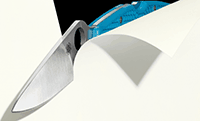 Take a piece of paper and hold it vertically. If you try to cut it with a dull knife, the paper will crumple beneath the knife. A sharp knife will cut it cleanly when use a slicing motion to cut through the paper. A razor sharp knife can cut the paper cleanly by just pressing down on the edge of paper without any slicing at all.
Take a piece of paper and hold it vertically. If you try to cut it with a dull knife, the paper will crumple beneath the knife. A sharp knife will cut it cleanly when use a slicing motion to cut through the paper. A razor sharp knife can cut the paper cleanly by just pressing down on the edge of paper without any slicing at all.
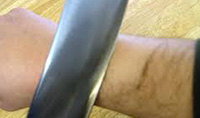 Another test is to shave the hair on your arms. A dull or even moderately sharp knife will just fold over your arm hairs without cutting. A well sharpened knife will cut almost all of the hairs in one pass. A “devil” sharp knife will cut all the hairs in its path. This level of sharpness can only be attained using the finest tools. (source)
Another test is to shave the hair on your arms. A dull or even moderately sharp knife will just fold over your arm hairs without cutting. A well sharpened knife will cut almost all of the hairs in one pass. A “devil” sharp knife will cut all the hairs in its path. This level of sharpness can only be attained using the finest tools. (source)
Moreover, I beg you to invest in a honing steel and utilize this powerful tool before rushing right into sharpening an edge. I have brought dull knives back from the dead by merely honing that blade. This will save you time and money which can both be invested elsewhere.
You may also like:
 How Bob Makes His Meteorite Knives
How Bob Makes His Meteorite Knives
H2O Dynamo – The Awesome DIY Device That Turns Air Into Fresh Water! (Video)

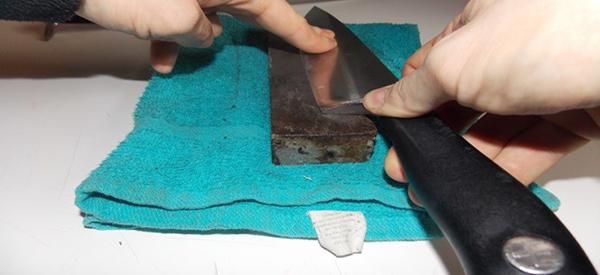




















Very interesting. At one time I was in to sharping knifes and I under stand the 22.5 degrees etc I got good but never good enough to be satisfied with my work. Your right to learn to sharpen with out any tools and the art is in your wrist and be consistent with your angle then you can sharpen anytime and any where.Thanks for posting it.
You shouldn’t cut paper it will slightly dull the blade, try shaving a small part of arm hair.
Have been using these techniques for 45+ years. Recommend getting good dual side stone, coarse one side fine other side. Will bring to usable edge for most knives. Fine Arkansas stone for finish before leather strop.
I have a 3000/8000 grit is that too fine of a stone? Have sharpened a couple of knives well using leather after. But need more practice of course.
After stoning, work blade back and forth on the top of your vehicle window to get diamond edge.
The bottom of almost any coffeecup or ceramic plate is a good makeshift sharpening stone when you’re in short of regular sharpening tools or car doors. ?
But the edge of a car window is good for “fine tuning” the edge after honing it on a flipped coffeecup. ?
The metal in knives seems to be less quality than 60 years ago.
60 years ago The knives were made from high carbon steel. This steel sharpens better than stainless, but rusts like crazy. The stainless steel they use now has improved a great deal over the years, but in my opinion still is not up to high carbon steel in the hands of a good blacksmith. I have been sharpening knives for more than the last 60 years
I am not an expert in this field, but that is definitely my experience as well. And I love the 400 grade stainless steels.
When hunting and my knife needs a touch up I pull my jeans tight over my thigh and use the denim as a strap. Quick touch up that helps speed up gutting, and skinning. For years I carried a small 1X3″ Arkansas stone in a plastic case. It really worked well, so well someone else thought they needed it more than I did. It was 30 – 40 years old, and I never found a replacement for it.
look up Smith Co. in Hot Springs, AR
Arkansas stones have been the standard for years.
Thank you
a wet stone uses water as a lubricant. never put oil on a wet stone you will destroy it They are readily available from woodworking stores I have used them for years and get a great edge.
Smith’s sells one
the Coors co. engineered many ceramic products, among them were small plates of ceramic armor. they can be used for an excellent honing stone after the wet stones.
Great article and pictures! I have always struggled to get a decent edge going! I also admit I am not patient with this task. I have to ask how do I find out if my whetstone is a “water stone?”. I confess to having used 3-in-one oil on mine! Please educate!!! Thank you very much!
The good news is that you can continue to use as a sharpening stone using oil, the bad news is that it is my understanding that you can never use as a water stone once you have oiled. Just keep using the oil, should be fine.
Dennis
I stopped reading after “wet stone.” If the tools of the trade are not known by their proper names, how much more can there be to read?
It’s a “WHET” stone.
Sorry, but both wet and whet stone are correct
Sorry, Benny, but all the dictionaries redirct to whet and most state that “wet stone” is incorrect. I have been reading for going on 70 years and only in recent years have I seen whet stone referred to as “wet.” Usually the writer has not done thorough research or misunderstands the pronunciation.
It is the same thing with using the leather STROP, not strap. You strop your razor blade on leather or blue jeans or any other finishing material.
If you used oil on a waterstone throw it away and buy a new double sided one.you do not have to be patient. a course waterstone removes steel very fast
waterstones seem to come in shades of tan. At least any I owned. The finer the stone the lighter the color.I hone the blade on a charged piece of leather.
Am I supposed to only use water on a whetstone? Thank You!
A wetstone is used with water. It is my understanding that you are not supposed to use anything with a whetstone.
robertharrington: what polishing compound grits do you use and what source? Thanks
Totally wrong dude! He’s using Japanese style WET stones! Designed to be used with water as a lube and to create a slurry. They are more commonly sold as waterstones… but he does know what he is talking about.
Sir,
If you would have kept reading. The author is using Japanese sharpening stones. Those stones are soaked in water for a minimum of Twenty mins. And are called “wet” I understand the haste in which to debunk so-called experts in todays YouTube accessiblity; however, it is possible to learn something from someone who comes from a different sphere of learning. So take care for your high horse might throw you not to mention your hubris
Schrade used to make a leather sheathed hone steel that was cat’s meow for smaller blades. The leather sheath snapped into the end of the steel as a safe handle when using the steel. I used the edge of this steel more than the flat.
That being said, unless I’m sharpening a knife for surgery, a butchers steel is good enough. These are actually better for sharpening Skandi grind or true boning knives than any quick stick or V system.
If my knife can shave hair off my arm, it’s good to go for anything short of surgery.
Chopping of firewood is a different story.
Some really interesting details you have written.Helped me a lot, just what I was searching for :D.
Many of the photos on this article are copyrighted images owned by me please remove all the photos. The original source is http://www.itstactical.com/warcom/knives/how-to-sharpen-a-knife-while-minimizing-mistakes-and-maximizing-cutting-edge-performance/
WAA WAAAAH, SO WHAT, IF IT HELPS A FELLOW AMERICAN -LET IT BE.
its just pictures why get ur panties in a wad over something as stupid as an image, LET IT HELP people SURVIVE OR LIVE.
Copyrighted work is a property right. The owner of the copyright has the same rights to the use of the work as you do for the money in your wallet. The author of this article could have contacted the owner of the copyright for permission to use his property. He chose not to do so. That puts him in the same category as the guy who dips your wallet and takes your money. While many see no harm in stealing copyrighted work, it all boils down to plain theft. Many who steal money also justify their thievery.
Well said, indeed.
And the pictures are actually Very Poor Quality, especially the lighting!
That’s what you get when you steal work product. You aren’t working off the original but off of some copy. Second, third and further down the line never get better. Each succeeding copy job includes the errors in the previous copy plus introduces its own.
Great article! We will bee linkiing tto this particularly great content on our site.
Keep up the great writing.
Learning to use stones from natural resources such as river stones for a substitute to factory made wet stones is a good outdoor survival practice.
It will prep you with an invaluable knife sharoening skill in case of emergency.
The most important part of sharpening a blade is to keep the same angle the entire length of the blade. Lansky sharpening kits are the best for this because of the way they are designed to hold the sharpening stone.
A cheap and easy way to sharpen blades is by using various grits of sandpaper clipped, clamped or glued to a flat board or paint mixing paddle. One can finish with a piece of cardboard or strip of cloth with some polishing compound or even toothpaste rubbed onto it. After sharpening, you drag the edge of the blade against the strop, moving back and forth against it and then clean the blade.
I use this method in my shop for freshening the edge on a blade I am using when I don’t want to take the time to drag out my stone and soak it in water. It’s especially handy for putting the edge back on a single edge razor blade if I am cutting up a lot of boxes.
Sorry, Benny, but even online dictionaries automatically default to “whet” stone and many state that “wet” stone is often misused. I have been reading knife articles going on 70 years, now, and only in very recent years have I seen whet stones referred to as “wet.” There may be old articles making the reference, but I have not seen them. Usually, the term wet is used by a writer who has misunderstood the term and has not bothered to research the subject thoroughly.
an equally if not more efficient of a honing steel is one made from the tempered glass filament from a large grow light bulb, I imagine the filament from any HPS or mercury vapor light would work as well.
The gentlemen who OWNES the right to his own picture is 100% correct.
However; why would one place his picture in a place where others would copy it, unless of cause it was meant to just be viewed.
The way the owner of the pictures earns a living is to sell the right to use the pictures to various entities that want to use them to illustrate an article such as this. The copyright thief takes the pictures that have been reproduced by permit and copies them using any number of devices. That reduces the value of the picture in several ways. First of all, as I pointed out above, every time the picture is copied from a copy the quality diminishes. Usually the thief uses the cheapest method available to him to copy the picture. If he was interested in high quality reproductions, he would pay the money to the owner of the photos and get suitable media for reproduction.
Perhaps the thief in this case stole the pictures from a magazine article such as Blade magazine which had paid the owner of the copyright for the use of his pictures. The thief might have taken pictures of the printed pictures in the magazine then incorporated them in his article here. By the time they get to your computer or phone of pad they again have been reduced in quality.
Printing plates are made from negatives which are made from the original artwork. The plates then print the image on a rubber blanket which then prints the image on the paper, so by the time one gets around to photographing printed images in a magazine with his pocket phone, he is copying images several stages away from the original. Most popular magazines are printed by offset press on fairly inexpensive light weight coated paper. National Geographic, a magazine noted for high quality reproductions in its publication in the past printed by rotogravure, an expensive process usually reserved for collector art books and printing currency. The folding money you have in your wallet is printed by rotogravure presses where the engraved plate prints directly onto the paper as opposed to offset printing which can approach the quality of rotogravure, can never equal it.
When someone uses a copyrighted product without permission, it is a civil offense subject to paying penalties in a court of law and it is also a federal felony offense carrying rather stiff fines and imprisonment. Luckily for the person who stole these photos, copyright theft is usually handled in civil court. The U.S. Attorney General rarely gets involved in prosecuting copyright theft. It is only charged where the thief is a public personage and the Deputy AG can get the media out for a publicized perp walk that gets the AG’s mug on the six o’clock news.
This completes the chapter on Printing Overview 101.
Interesting. English is such a confusing language. Whet is to edge or sharpen a blade so a whet stone is one that is designed for sharpening. Wet is the state of something being covered with liquid. That liquid could be either oil or water. Oil or water can be used on abrasive stones to crest a slurry with the fine metal particles ground off the blade. Otherwise those fine metal particles would plug the pours of the abrasive stone making it less effective. The slurry can be simply wiped away. Course stones are less likely to become plugged or need to be wet. Sharpening is simply creating a cutting edge on a blade to cut fibrous or soft materials. There are many ways to create an edge including abrasive stones, ceramic abrasives, diamond abrasives, hard steel edges, files, abrasive belts, rouge wheels and many more. I have been a leather craftsman for many years and have tried every sharpening system I could find. I’m sure I missed a few. Leatherwork requires razor sharp tools. I also worked in a hardware store where I sharpened everything imaginable. I’ve tried many different methods and here’s what I’ve learned. For kitchen knives I have encouraged customers to try using a steel to correct the edge on cooking knives before a stone or other method. The steel or hone will correct the edge resulting in less frequent grinding of knife edge. Eventually the edge will need correcting by removing material. Narrow angles like 17deg are more razor like but are also vulnerable to deforming or chipping and require more care and maintenance. Wider angles like 20deg are more durable and can take more rough use. Maintaining a precise angle is the trick. Frankly i use a regular metal file on lawnmower, scythe, or axes and hatchet edges. The finer edges are the most difficult. Some methods create a burr or very fine edge of metal that is rolled over and must be removed or stropped off to finish the edge. Ask an older barber. I think the original article was essentially correct in the information covered but necessarily limited by the scope of the subject matter.